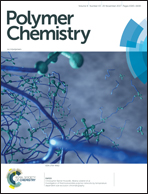Investigation of thermoreversible polymer networks by temperature dependent size exclusion chromatography†
Abstract
Herein we present an advanced analytical protocol for investigating the debonding of thermoreversible polymer networks to enable their in-depth understanding in applications ranging from self-healing materials to 3D additive manufacturing technology. Specifically, the debonding (or de-crosslinking) of a thiocarbonylthio-based hetero Diels–Alder (DA) network is studied in situ by temperature dependent size exclusion chromatography (TD SEC). As the network can be disassembeld at elevated temperatures, its fragments are readily accessible for in-depth analysis by triple-detection TD SEC with refractive index, UV/Vis- and viscosity detection. Critically, the different stages of de-crosslinking can be assessed via the released fragments in terms of their chemical composition and conformation. The results indicate that very broadly distributed and highly branched fragments are released during the initial stages of the disassembly, while more narrowly distributed polymers are expelled at higher degrees of de-crosslinking. In contrast to spectroscopic methods, the introduced chromatography-based approach is potentially applicable to systems of variable chemistries and captures the diverse nature of the de-crosslinking products.



 Please wait while we load your content...
Please wait while we load your content...